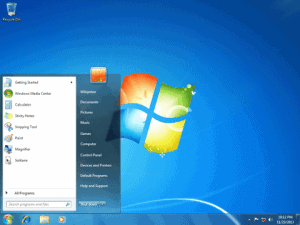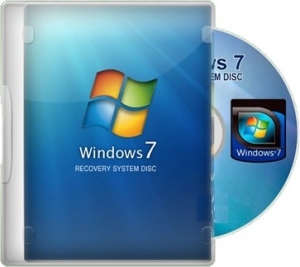Windows 7 Support ending soon
Well it’s not long now before Windows 7 reaches End Of Life (EOL). So what does this mean for you, and what do you need to do?

Well it’s not long now before Windows 7 reaches End Of Life (EOL). So what does this mean for you, and what do you need to do?
 This will not please a lot of my customers, but it had to happen sooner or later.
This will not please a lot of my customers, but it had to happen sooner or later.
Microsoft have given notice to its OEM (Original Equipment Manufacturer) partners that they must no longer sell PC’s or Laptops with an Operating System older than Windows 10 from the middle of next year.
According to Microsoft’s Windows Lifecycle Fact Sheet, Windows 8 sales must also end as of 1st July next year, and Windows 7 Professional and Windows 8.1 will no longer be allowed to be pre-installed on new PC’s and Laptops from 1st November 2016, .
The Home Basic, Home Premium and Ultimate editions of Windows 7 were retired by Microsoft on 1st November last year.
Windows 7 launched in October 2009, and Microsoft has permitted it to continue to be sold substantially longer than Windows 8, and Windows 8.1 which both arrived in 2013.
So I guess the salient point here is that if you want a new PC or Laptop with Windows 7, you will need to purchase it within the next 7 or 8 months.
 Well here is a handy website to know about.
Well here is a handy website to know about.
I don’t know how many times a customer has come to us, either wanting their Windows 7 PC or Laptop wiped and reinstalled, or it has needed repairing using Recovery Media, but they do not have their Recovery Media or a Windows 7 Disk.
Now this isn’t a particularly big problem for us because we have access to Windows OEM Disks, but for the End User, not having the Recovery Media is a huge problem that means they have no other choice but to pay someone to do it for them.
Help is at hand. By visiting the Microsoft Software Recovery website, the End User can download the ISO file required to burn their own Recovery Media disk. The size of the disk will be somewhere between 2GB and 3.5GB, so if you are on a limited Internet Plan or a Mobile Internet Plan, just be careful you do not exceed your download limit.
Microsoft even provide a link for software to burn a DVD from an ISO file if you don’t have suitable software installed to do that yourself. Once you have the software and a valid Product Key, you’re off and running.
The website also allows you to create a bootable USB drive with a copy of Windows 7 on it.
All-in-all, a very handy thing to know if you never had a disk, or you have damaged your disk. As we all know, it is impossible to reinstall or even undertake some really easy repairs without a Recovery Disk or Windows 7 Media.
Of course there will be some End Users that will still have difficulties installing Windows 7 even if they do have the disk. For example, you will still need to download the Windows Drivers from the appropriate hardware manufacturers websites. But if that is the case, Spotty Dog Computer Services can certainly do that for you 😉
Are you bored with the default Clock Gadget in Windows 7?
If so, take a look at these free Vector Clock Gadgets!
Vector Clocks is a collection of clocks, all of them are unique and will jazz up your desktop.
There are heaps of changes you can make to these clocks, including the ability to change the transparency, you can rotate them, change the shadow colors, set alarms and lots of other modifications can be made.
Simply right click on the clocks and edit the settings.
You can download the clocks separately or all together as a single installer package.
PLEASE NOTE that the Installer Package may come with a PRE-CHECKED option to install bundled software. You should UN-CHECK that option.
I installed and tried out the Blue Rumba Clock on my Windows 7 desktop and it looked pretty cool!
Download page: Vector Clocks.
With the last pre-release version of Windows 8 in hand, PCMag decided it was time to compare Microsoft’s next OS with its last.
Here is their summary of test results.
Article by Michael Muchmore
We’ve heard it before: The next version of Windows is going to start up way faster and run faster than the last. With Windows 7, we were told that we could expect 15 second boot times, but that sure hasn’t been my experience. With Windows 8, it looks like the claims are for real: In using the Windows 8 Developer, Consumer, and Release Previews, I’ve noticed a huge improvement in startup times. No longer do you have to wait for nearly a minute just to log into a typical PC.
And the company has stated that it’s working on reducing another big source of waiting time: Updates. If you don’t use a Windows 7 PC for a week or so, chances are that you’ll have to wait a few minutes for it to download and install updates, and you’ll probably have to go through a second reboot. This is less of a problem for PCs that are left on all the time (to the detriment of energy conservation), which is the case for most business PCs.
In addition to startup and shutdown times, I wanted to compare performance of Windows 8 with that of Windows 7 on some other measures. I used PCMark, Geekbench, and three browser benchmarks. I also timed how long it took to copy large files and encode a video project.I first installed a fresh clean copy of Windows 7 Ultimate (64-bit) on a Toshiba Portege R835-P88 laptop (a PCMag Editors’ Choice) with a 2.5GHz Core i5-2450M chip, 6GB of RAM, a 500GB hard drive, and an Intel HD Graphics 3000 integrated graphics processor. I ran all the tests, and then installed a clean copy of Windows 8 (64 bit) on the same hardware. For each OS, I made sure all updates had been installed.Startup and Shutdown TimesFew performance issues are more important than how long it takes your computer to start up and be ready to use. Windows 8 makes bigger advances in this yardstick than any operating system in memory. Of course, our tests involved clean OS installations, and startup time can be affected by apps you install that load code during startup, such as antivirus. But this, too, is more of a problem for Windows 7, since Windows 8 saves the system state and memory contents to a file on disk, and simply reloads it on reboot, rather than initiating everything all over again.
Another factor for the new OS is behavioral—it’s designed to encourage the user to “sleep” the machine rather than completely shutting it down when use finishes. And, maybe most importantly, with newer hardware that uses a UEFI (Unified Extensible Firmware Interface) hardware boot process and SSD hard drives, you’ll see even more drastic startup speed boosts. But even without all this, my startup results showed that the upgrade reduced startup time to less than half that of Windows 7. Shutdown time was improved, but not by such a wide margin.
Large file set move
One of the few improvements to the traditional Desktop interface that lurks beneath Windows 8’s newfangled Metro user interface is file moving and copying in Windows Explorer. It’s not just the cosmetics of the added ribbon atop the Explorer that’s been changed: Now, when you copy or move multiple files simultaneously, you’ll also see an information box showing each operation’s progress, with an optional throughput graph. To test file-move performance I used a USB 2.0 thumb drive loaded with 500MB of 81 large files of mixed types. I also tried a single large file of just under 1GB.The newer OS also did a better job predicting how long the move operation would take. Though these tests didn’t show a speed improvement (presumably because it’s a hardware-constrained test), when I tried copying the same files to another folder, it was nearly instant, whereas in Windows 7 I had to wait the same time for the file to move again.
Geekbench
Geekbench 2.3, from Primate Labs, runs a series of geeky tests like prime number, Mandelbrot, blowfish encryption, text compression, image sharpen and blur, and memory stream test. The subtests comprise both single- and multithreaded applications. The results are normalized so that a score of 1,000 is the score a Power Mac G5 1.6GHz, so a higher number is better.I ran both the 32-bit and 64-bit tests in Geekbench three times and took the average for each OS. Mostly designed to test hardware, Geekbench didn’t show much change between OS versions. But it’s encouraging that this test version of Windows 8 was a tad faster, rather than slowing down the benchmark’s operations.
Video Rendering
For a real-world, task-based test, I timed video encoding in Windows Live Movie Maker on both operating systems. I used the same 2-minute movie content (made of three different format clips I created, complete with titles and transitions), and had the program convert it to 720p at a 12.26Mbps bandwidth. Windows 8 posted a slight but encouraging improvement on this test, reducing the time it took from 1 minute and 22 seconds to 1:11.PCMark Vantage
The PCMark 7 benchmark runs 7 system tests, each designed to represent a certain type of PC usage, including hard disk access, 3D and graphics physics rendering, Web page rendering, file decryption, and multithreading with video, and image manipulation. The benchmark spits out a result in PCMarks, with a higher number equating to better performance. My Windows 8 system showed a significant performance improvement over Windows 7, upping the score by 388 points.Browser Benchmarks
I tested browser performance in Windows’ native browser Internet Explorer. On Windows 8, that would be version 10, and on Windows 7 I used the latest version available for that OS, IE9. I ran two popular JavaScript benchmarks, SunSpider and Google’s V8 (v.7) as well as a Microsoft test of hardware acceleration, Psychedelic Browsing. I ran the tests in the Desktop version of Windows 8’s Internet Explorer 10 browser.The improvement on Sunspider and V8 was remarkable: Microsoft has clearly done further optimization on IE10’s JavaScript engine, Chakra. And the Psychedelic Browsing test showed a marked improvement as well, meaning Microsoft has done further work on hardware acceleration in the browser.
Without further ado, my results are presented in the table that follows:
Windows 7 Utimate
(64-bit)Windows 8
(64-bit)Startup
(seconds, lower is better)38 17 Shutdown
(seconds, lower is better)12.2 9.9 500MB File Group Move
(seconds, lower is better)25.2 29.2 Large Single File Move
(seconds, lower is better)46.4 46.8 Video Rendering
(minutes:seconds, smaller is better)1:22 1:11 Geekbench 2.3 64-bit tests
(higher is better)8090 8187 Geekbench 2.3 32-bit tests
(higher is better)5962 6122 PCMark 7
(higher is better)2313 2701 Sunspider
(ms, lower is better)180 144 Google V8 (v.7)
(higher is better)3079 6180 Psychedelic Browsing
(higher is better)3997 5292
The key thing here is startup. Windows 7 still takes just too long to get usable, and Windows 8 finally remedies this drawback. Browser performance is also notably better, and it’s encouraging that Geekbench showed a little improvement and PCMark 7 a significant one. Yes, this is not even the RTM, or final release of Windows 8, but the early test results are encouraging. New hardware will, of course, make the new OS scream, particularly if you opt for SSD storage.
Article Source: PCMag.com
This is why you should look at making sure you have Service Pack 3 (SP3) installed, or think about migrating to Windows 7 in the near future.
Microsoft has announced that support for Windows XP with Service Pack 2 (SP2) 32-bit operating system will end on 13th July 2010, and support for Windows Vista Release to Manufacturing (RTM) will end 13th April 2010.
If you are running the 64-bit edition of Windows XP with SP2, you will continue to be eligible to receive Microsoft support and updates until 8th April 2014. There is no SP3 for the 64-bit version of Windows XP. To find out if you are running the 64-bit version of Windows XP, go to the Start menu, right-click My Computer, and then click Properties. If you don’t see “64-bit” listed, then you’re running the 32-bit version and need to install the Windows XP SP3.
Beachmere 4510, Beerburrum 4517, Bellmere 4510, Burpengary 4505, Caboolture 4510, Caboolture South 4510, Dakabin 4503, Deception Bay 4508, Elimbah 4516, Kallangur 4503, Kurwongbah 4503, Moorina 4506, Morayfield 4506, Narangba 4504, North Harbour 4505, Rothwell 4022, Upper Caboolture 4510.
Other areas may be possible on request.
I took the plunge and upgraded from Windows 10 to Windows 11. Ok. It looks slicker, a bit of window dressing as far as aesthetics are concerned, and I won’t go into Window’s 11’s features and functions. But the thing that immediately strikes you is …
I took the plunge and upgraded from Windows 10 to Windows 11. Ok. It looks slicker, a bit of window dressing as far as aesthetics are concerned, and I won’t go into Window’s 11’s features and functions. But the thing that immediately strikes you is …
With ever increasing actions by “Big Tech” in general to collect more and more data about us, and the rise in Governments monitoring what we are doing as well as our ISP’s, I’ve been meaning to write something like this for some time now.
But it was the recent actions by FaceBook to take down News Pages and Links…
Well it’s not long now before Windows 7 reaches End Of Life (EOL). So what does this mean for you, and what do you need to do?
I recently had dealings with Microsoft on behalf of a customer that I can only describe as disgraceful and disappointing. The customer in question was an elderly lady with Parkinson’s disease. She had been the victim of a crypto-virus attack, and I had no alternative other than ….
Mon to Thur: 8:30am – 4:00pm
Closed: Fridays, Weekends, & Public Holidays
